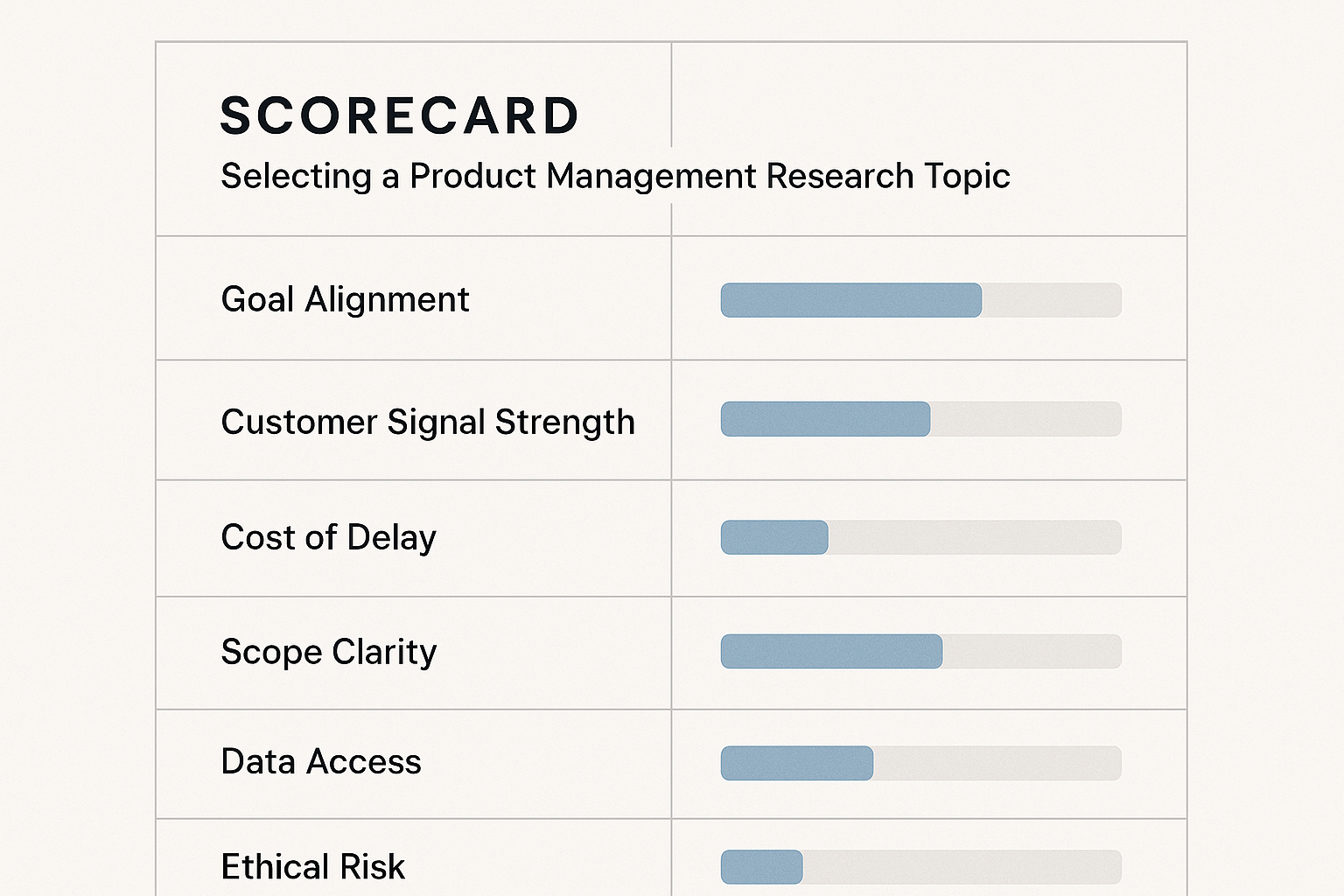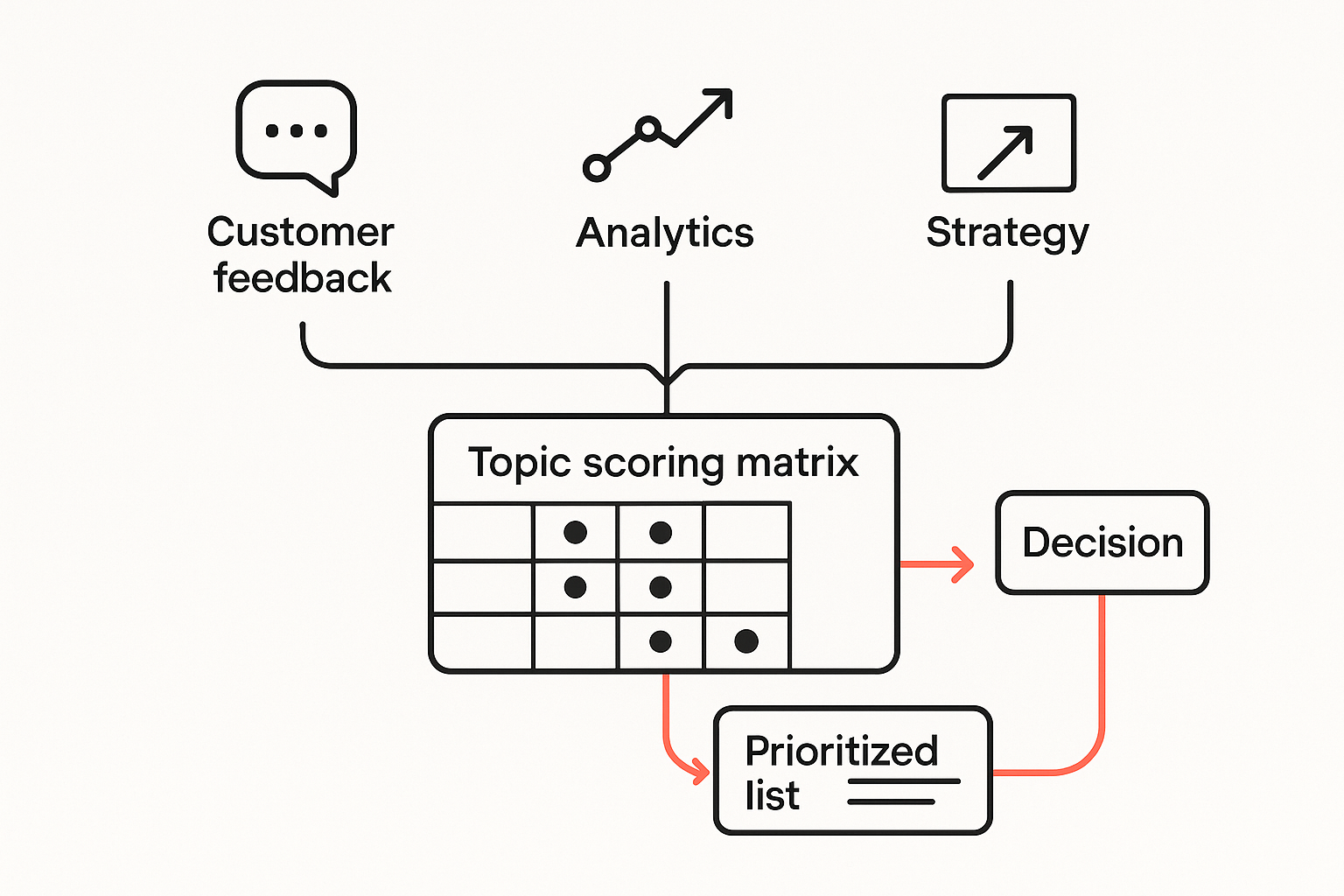# Start with the real problem
The hardest part of product management research is not the research, it is choosing what to research. In a week full of requests, metrics, and opinions, focus drifts. The right topic can unblock a roadmap and protect months of engineering time. Pick poorly and you dig decision debt.
We treat product management research like placing a bet. Small bet, clear odds, defined payoff. That mindset keeps us honest and keeps the work tight.
# A simple scorecard for topic selection
Use a short scorecard to compare research options. It favors clarity over volume.
Score each topic from 0 to 5 on six criteria:
- Goal alignment: Does this connect to a current OKR or revenue goal, not a generic improvement?
- Customer signal strength: Do you see repeated feedback, churn notes, or usage patterns pointing to it?
- Cost of delay: What happens if we wait one quarter?
- Scope clarity: Can you describe the decision you will make in one sentence?
- Data access: Can you reach users and data within two weeks?
- Ethical risk: Any privacy, fairness, or safety concerns to explore early?
Add the scores, then sanity check with judgment. Numbers help, they do not decide for you.

# Where strong signals come from
When in doubt, start with the customer. The best signals are near the work, not buried in a slide deck.
- Feedback board themes and upvotes
- Support tickets tagged by issue type
- Churn and expansion reasons from calls
- Product analytics for activation and retention
- Sales notes where deals stall
If you already centralize product feedback, you can synthesize themes faster. Tools that cluster comments, spot duplicates, and tie feedback to accounts cut hours. We use that approach to move from noise to a short list of research topics. If you want an example of automated insight surfacing, see how Sleekplan Intelligence groups feedback by theme and impact: Sleekplan Intelligence (opens new window).
# The 60 minute filter
Timebox the choice so it does not expand to fill the week.
- Minute 0 to 10: List 5 to 8 possible topics. Write the decision you need for each.
- Minute 10 to 25: Pull signals. One query per source, one chart, one call note. No rabbit holes.
- Minute 25 to 40: Score quickly using the scorecard. Add one sentence of rationale per criterion.
- Minute 40 to 55: Compare top two. Ask, what would change in the next 14 days that might flip this decision?
- Minute 55 to 60: Choose. Write a crisp research brief with scope, methods, and exit criteria.
Clarity beats certainty. You are choosing a starting line, not a finish.

# A worked example
Three tempting topics land on your desk:
- Improve onboarding with an AI guide for first week adoption
- Redesign the pricing page to reduce plan confusion
- Map the activation journey to fix a drop between signup and first value
Now score lightly:
- AI onboarding: Goal alignment 3, signal 2, cost of delay 2, scope clarity 3, data access 4, ethical risk 3. Total 17.
- Pricing page: Goal alignment 4, signal 4, cost of delay 4, scope clarity 4, data access 3, ethical risk 4. Total 23.
- Activation journey: Goal alignment 5, signal 5, cost of delay 5, scope clarity 3, data access 3, ethical risk 5. Total 26.
Pick activation. Why, because repeated feedback mentions confusion before first value, the cost of delay is high, and the decision is concrete. The brief might be: identify top two blockers to time to value under 10 minutes, propose one change that can ship in 14 days, then measure activation lift within 30 days.
# Methods to fit the question
Choose methods that match the decision, not prestige.
- To unblock activation: 5 user interviews, 3 screen shares, 1 log study, 1 prototype test
- To price or package: value testing with real plan names, sales call reviews, competitive teardowns
- To size a retention issue: cohort analysis, job stories, diary studies with active users
Small samples are fine when the signal is strong. Quality of observation beats sample size.
# Avoid common traps
We see the same mistakes, even on seasoned teams.
- Vague outcomes: Everything sounds important, nothing is testable
- Novelty bias: The shiny idea jumps the queue, the core problem waits
- Proxy metrics: Engagement goes up while activation stays flat
- Over research: Weeks of interviews without a decision
- No exit criteria: The team keeps digging, the roadmap freezes
Keep one rule: if the research cannot change a decision, do not start it.
# Deliverables that keep momentum
Top off the process with crisp artifacts that fit on one page:
- One page brief: decision, methods, sample, exit criteria
- Topic scorecard: final scores plus two lines of reasoning
- Timeline: week one discovery, week two synthesis, week three decision and shareout
- Impact review: did the decision change and by how much
These are small on purpose. Minimal overhead encourages better craft and more ownership.
# FAQ: How do you choose a product management research topic?
- Tie it to a current goal
- Validate with customer feedback and analytics
- Estimate cost of delay
- Check access to users and data
- Define exit criteria for the research
Pick, commit, and write a one page brief before you book the first interview.
# Principles behind the process
- Quality over speed: A sharp brief saves sprints
- Detail matters: The exact decision sentence keeps you honest
- Human judgment: Scores inform, product sense decides
- Ownership: No half finished research, hand it off with a recommendation
- Clarity: Clear writing forces clear thinking
# When to stop researching
Stop when you can make the decision you set in the brief, not when you run out of time. If new learning would not change the call, ship the recommendation and move.
I keep one personal rule. If I cannot explain the decision in five lines to a skeptical engineer, I am not done.